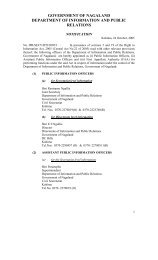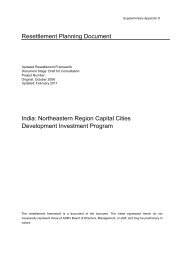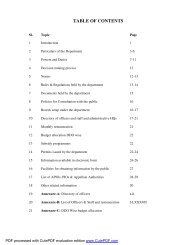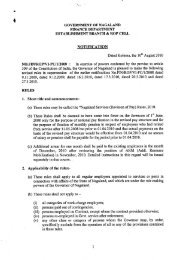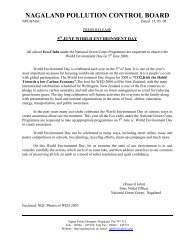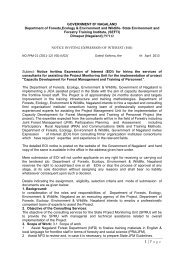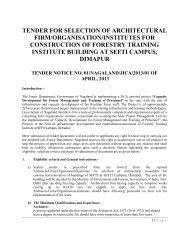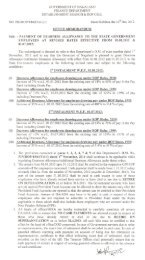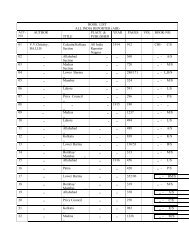DRAFT Sector Paper: Power and Renewable Energy Nagaland ...
DRAFT Sector Paper: Power and Renewable Energy Nagaland ...
DRAFT Sector Paper: Power and Renewable Energy Nagaland ...
You also want an ePaper? Increase the reach of your titles
YUMPU automatically turns print PDFs into web optimized ePapers that Google loves.
A field trip to interact with villages/communities across 6 districts of Nagal<strong>and</strong>,namely, Mokokchung, Tuensang, Wokha, Phek, Kiphire <strong>and</strong> Peren <strong>and</strong> hadmeetings organised at Pfutsero, Meluri, Pungro, Tuensang, Alisofor <strong>and</strong> Wokha withinteraction with a wide range of people representing communities, farmers, districtadministrative officials, officials from the forest department, NGOs <strong>and</strong> civil societygroups among others.Some of the common issues across the region that we visited, with regard to “energyaccess” was as follows:a) Most of the villages in the region had electricity accessb) But the quantum of electricity supply was extremely low, primarily – low voltagewas a common issuec) In terms of hours of supply, while the supply ranged from 4-10 hours a day, thecommon feed back was that most of the supply was during the day time, whenthe need for electricity was the least. The biggest issue was that most often thannot, the supply of electricity during night hours <strong>and</strong> early morning hours, wherethe need was the highest, was extremelylow <strong>and</strong> erraticd) Bulk of electricity supplied was primarily was lighting purposes. Due to lowvoltage <strong>and</strong> quality of supply, most appliances would not worke) Much of the area that we visited being in the relatively higher altitude zones withpleasant weather almost through out the year, the need for air-conditioning wasnear zero. At best, fans would suffice. However, in winters, the need for waterheating was high <strong>and</strong> sometimes, there was also a requirement for room heaters.f) There was hardly any electricity supply for small <strong>and</strong> agro-based units <strong>and</strong> linkingenergy with livelihoods was not being practiced, again due to erratic <strong>and</strong> lowquality supply.g) The time taken to rectify faults took time – some time, as much as 5 to 15 days.One of the reasons that was attributed to this is that, currently, Nagal<strong>and</strong> hasonly one transformer repairing unit, which is located at Dimapur <strong>and</strong> hence,transporting the faulty transformer to Dimapur, getting it rectified <strong>and</strong> transportingit back to the location did take some timeh) The load shedding was highest during winter <strong>and</strong> summer months <strong>and</strong> this islargely attributed to the fact that bulk of the energy for the state comes fromHydro sources <strong>and</strong> during dry seasons, the state gets a lesser power allocationfrom the Central Grid.1.5 Likely Impacts of Climate Change on the Electricity/ <strong>Energy</strong><strong>Sector</strong>1.5.1 Increase in <strong>Energy</strong> Consumption<strong>Energy</strong> consumption of a city is closely related to its ambient temperature. However,urban temperature is changing because of heat isl<strong>and</strong> effect <strong>and</strong> global warming. TheInternational Panel on Climate Change (IPCC) forecasts that the global temperature willbe rising in the next 100 years] 1 ; the temperature rise in 2100 relative to 2000 wouldrange from 1.4 to 5.8 1C under different adaptation scenarios.1 Fourth Assessment Report, IPCC, 200711




